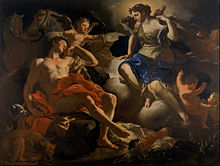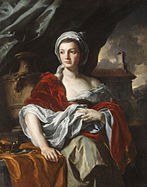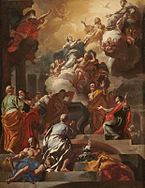art.wikisort.org - Artist
Francesco Solimena (4 October 1657 – 3 April 1747) was a prolific Italian painter of the Baroque era, one of an established family of painters and draughtsmen.
This article needs additional citations for verification. (March 2019) |
Francesco Solimena | |
|---|---|
 Self-portrait, 1730 | |
| Born | 4 October 1657 |
| Died | 3 April 1747 (aged 89) |
| Nationality | Italian |
| Education | Francesco di Maria |
| Known for | Painting |
| Movement | Baroque |
| Patron(s) | Pope Benedict XIII |
Biography


Francesco Solimena was born in Canale di Serino in the province of Avellino.
He received early training from his father, Angelo Solimena, with whom he executed a Paradise for the cathedral of Nocera (a place where he spent a big part of his life) and a Vision of St. Cyril of Alexandria for the church of San Domenico at Solofra.[1]
He settled in Naples in 1674, where he worked in the studio of Francesco di Maria.[1] He was patronized early on, and encouraged to become an artist by Cardinal Vincenzo Orsini (later Pope Benedict XIII).[1] By the 1680s, he had independent fresco commissions, and his active studio came to dominate Neapolitan painting from the 1690s through the first four decades of the 18th century. He modeled his art—for he was a highly conventional painter—after the Roman Baroque masters, Luca Giordano and Giovanni Lanfranco, and Mattia Preti, whose technique of warm brownish shadowing Solimena emulated. Solimena painted many frescoes in Naples, altarpieces, celebrations of weddings and courtly occasions, mythological subjects, characteristically chosen for their theatrical drama, and portraits. His settings are suggested with a few details—steps, archways, balustrades, columns—concentrating attention on figures and their draperies, caught in pools and shafts of light. Art historians take pleasure in identifying the models he imitated or adapted in his compositions. His numerous preparatory drawings often mix media, combining pen and ink, chalk, and watercolor washes.
A typical example of the elaborately constructed allegorical "machines" of his early mature style, fully employing his mastery of chiaroscuro, is the Allegory of Rule (1690) from the Stroganoff collection, which has come to the State Hermitage Museum, St Petersburg.
Francesco Solimena amassed a fortune and lived in sumptuous style founded on his success. He died at Barra, near Naples, in 1747 at the age of 89.
As Solimena had intended it, his nephew Orazio became his pupil and successor as a painter.[2]
Career
His large, efficiently structured atelier became a virtual academy, at the heart of cultural life in Naples. Among his many pupils were Giuseppe Bonito (1707–89), Domenico Antonio Vaccaro (1678-1745), Nicola Maria Rossi, Lorenzo De Caro, Jacopo Cestaro, Andrea dell'Asta, Paolo De Majo, Ludovico De Majo, Pietro Capelli, Domenico Mondo, Onofrio Avellino, Scipione Cappella, Giovanni della Camera,[3] Francesco Campora,[4] Alessandro Guglielmi,[5] Leonardo Oliviero,[6] Salvatore Olivieri,[7] Salvatore Pace,[8] Romualdo Polverino,[9] Paolo Gamba, Bernardino Fera, Evangelista Schiano, Gaspare Traversi, Francesco Narici, Alessio D'Elia, Santolo Cirillo, Michele Foschini, Tommaso Martini, Alfonso Di Spigna, Michelangelo Schilles, Giovanni Battista Vela, Ferrante Amendola, Eugenio Vegliante, Romualdo Formosa, and most notably Corrado Giaquinto, Francesco De Mura and Sebastiano Conca. The Scottish portraitist Allan Ramsay spent three years in Solimena's studio.[10]
- Francesco Solimena
- Portrait of a woman
- Study for the fresco cycle of the Sacristy of a church[11]
- Venus at the Forge of Vulcan, 1704
- Madonna and Child
- Noli me tangere
- The Assumption
- The Annunciation
- Jacob's Dream

References
- Pavone, Mario Alberto (2003, January 1). "Solimena family". Grove Art Online.
- Pavone, Mario Alberto, Precisazioni su Orazio Solimena, in: Prospettiva, 20 (1980), pp. 80–87.
- Boni, Filippo de' (1852). Biografia degli artisti ovvero dizionario della vita e delle opere dei pittori, degli scultori, degli intagliatori, dei tipografi e dei musici di ogni nazione che fiorirono da'tempi più remoti sino á nostri giorni. Seconda Edizione.. Venice; Googlebooks: Presso Andrea Santini e Figlio. p. 171.
- Boni, page 177
- Le belle arti, Volumes 1-2, By Giovanni Battista Gennaro Grossi, Tipografia del Giornale Enciclopedico, Strada del Salvadore a Sant'Angelo a Nilo #48, Naples (1820); page 194.
- Camillo Minieri-Riccio, Memorie storiche degli scrittori nati nel regno di Napoli, L'Aquila 1844, page 243.
- Minieri-Riccio, page 243.
- Minieri-Riccio, page 248.
- Minieri-Riccio, page 279.
- "Francesco Solimena, Charles Beddington Ltd". Archived from the original on 8 January 2014.
- For sacristy of San Paolo Maggiore in Naples', Whitfield Fine Art
External links
- 35 artworks by or after Francesco Solimena at the Art UK site
- Francesco Solimena on-line
- J. Paul Getty Museum: Francesco Solimena
- Scuola Media F. Solimena, Canale di Serino.
- Farquhar, Maria (1855). Ralph Nicholson Wornum (ed.). Biographical catalogue of the principal Italian painters, by a lady. Woodfall & Kinder, Angel Court, Skinner Street, London.
- Wittkower, Rudolf (1980). Art and Architecture in Italy, 1600-1750. Pelican History of Art (Penguin Books Ltd). pp. 462–465.
На других языках
[de] Francesco Solimena
Francesco Solimena (* 4. Oktober 1657 in Canale di Serino, Provinz Avellino; † 3. April 1747 in Barra bei Neapel) war ein italienischer Maler und Freskant. Da er von Jugend an einen religiösen Habit trug, wurde er auch L’abate Ciccio genannt.[1] Solimena war nach Luca Giordano der führende Maler Neapels, das er fast nie verließ, erhielt aber auch viele Aufträge aus ganz Europa.- [en] Francesco Solimena
[es] Francesco Solimena
Francesco Solimena, llamado también l'Abate Ciccio, esto es, el Abad Ciccio (Canale di Serino, 4 de octubre de 1657; Nápoles, 3 de abril de 1747) fue un pintor italiano barroco.[fr] Francesco Solimena
Francesco Solimena (1657 - 1747), dit l'Abbé Ciccio, est un peintre d'histoire et de sujets religieux ainsi qu'un architecte de l'école napolitaine de la période baroque. C'est une des grandes figures du développement des styles baroque et rococo qui fut reconnu internationalement comme un des plus fameux artistes de son époque.[it] Francesco Solimena
Francesco Solimena, noto come l'Abate Ciccio (Canale di Serino, 4 ottobre 1657 – Barra, 5 aprile 1747), è stato un pittore e architetto italiano. Attivo in area napoletana, sia pure con committenze nelle maggiori corti europee, è considerato uno degli artisti che meglio incarnarono la cultura tardo-barocca in Italia.[ru] Солимена, Франческо
Франческо Солимена (итал. Francesco Solimena; 4 октября 1657 года, Канале-ди-Серино, Кампания — 3 апреля 1747 года, Барра (ит.) близ Неаполя) — итальянский художник эпохи позднего барокко, один из крупнейших представителей неаполитанской школы живописи.Другой контент может иметь иную лицензию. Перед использованием материалов сайта WikiSort.org внимательно изучите правила лицензирования конкретных элементов наполнения сайта.
WikiSort.org - проект по пересортировке и дополнению контента Википедии

![Study for the fresco cycle of the Sacristy of a church[11]](http://upload.wikimedia.org/wikipedia/commons/thumb/d/d9/SOLIMENA.jpg/164px-SOLIMENA.jpg)





